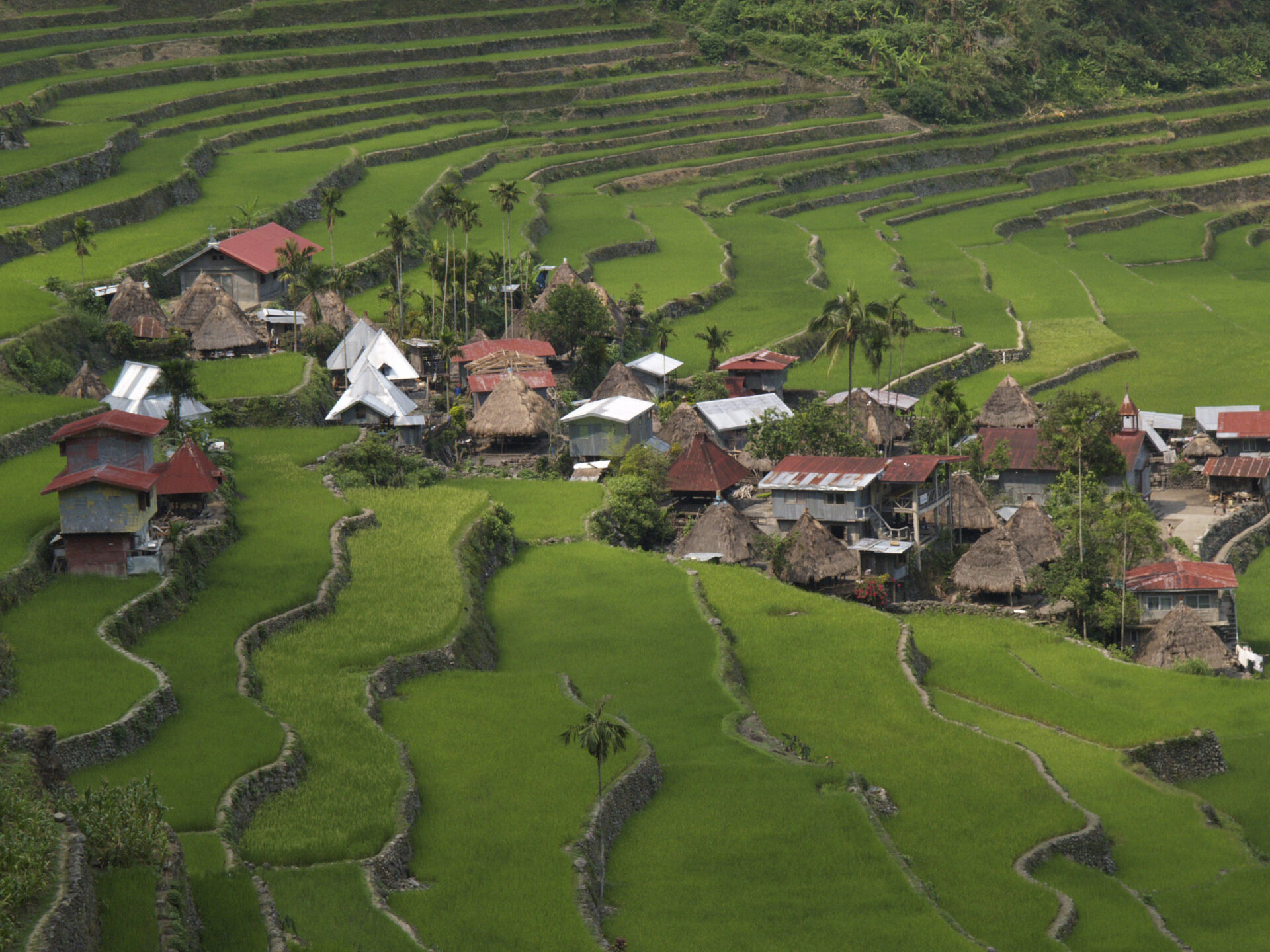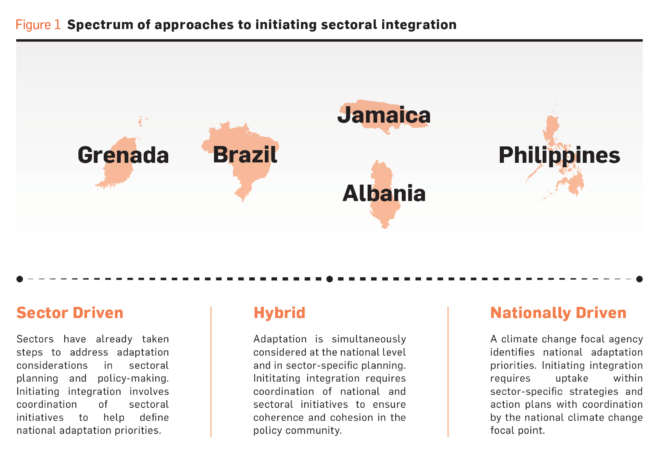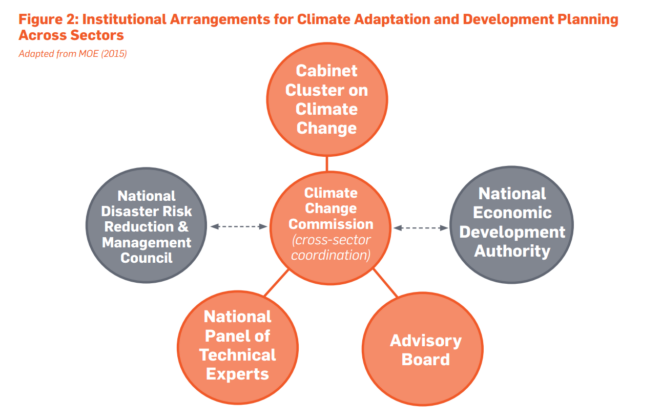sNAPshot: Philippines’s Approach to Initiating Sector Integration of Adaptation Considerations

Introduction
While there is no single approach to integrating adaptation considerations into sector planning, concrete examples are emerging as more countries pursue National Adaptation Plan (NAP) processes. South-South sharing of experiences through the NAP Global Network has shown that, in the early stages of NAP processes, the impetus for sector integration can be found in different ministries and at different levels depending on the country context.
A spectrum of approaches to initiating sector integration of adaptation emerged, ranging from sector-driven to nationally driven approaches.
Building on an earlier overview brief, this sNAPshot takes a closer look at how the Philippines initiated sectoral integration of adaptation considerations, and how this compares with approaches that other countries are taking.

Climate and Development in Philippines
The Philippines is a lower-middle-income country that is especially vulnerable to the impacts of natural disasters. The country’s economy is dominated by the services sector, which contributes over half of the nation’s economic output, followed by industry making up 31 per cent and agriculture accounting for 10 per cent. The Philippines is particularly susceptible to typhoons and tropical cyclones. Flooding and landslides also pose significant risks to the country.
The Government of the Philippines has identified the following priorities in addressing climate change:
- Food security
- Water sufficiency
- Ecosystem and environmental stability
- Human Security
- Climate-smart industries and services
- Sustainable energy
- Knowledge and capacity development
Plans and Strategies for Adaptation and Development
In 2010, the Government of the Philippines released its National Framework Strategy on Climate Change (NFSCC), which envisions a “climate risk-resilient Philippines with healthy, safe, prosperous and selfreliant communities, and thriving and productive ecosystems.” The framework stresses a balance between adaptation and mitigation, and laid the groundwork for the development of the National Climate Change Action Plan (NCCAP) for 2011– 2028 (Ministry of the Environment [MOE], 2015).
The NCCAP is the starting point for guiding integration of climate change priorities across sectors. The NCCAP provides guidance for both adaptation and mitigation and calls for due attention to the concerns of vulnerable sectors, prioritizing food security, water sufficiency, ecosystem and environmental stability, human security, climatesmart industries and services, sustainable energy, and capacity development.
The NCCAP is sub-divided into three phases of six years each, in alignment with the Philippine Development Plan (PDP) and the National Disaster Risk Reduction and Management Plan (Government of the Philippines, 2011a; MoE, 2015). The PDP for 2011–2016 is the country’s development framework that seeks to address poverty, create employment opportunities and achieve inclusive growth. Climate change is an important cross-cutting topic within the PDP, recognizing the vulnerability of the Philippines to climate-related hazards. (Government of the Philippines, 2011b).
Institutional Arrangements for Climate Adaptation and Development Planning Across Sectors
The Climate Change Commission (CCC), an agency attached to the Office of the President, was established pursuant to the Climate Change Act of 2009. The CCC is mandated to lead the coordination, monitoring and evaluation of climate change-related plans and programs in the Philippines with support from an Advisory Board and National Panel of Technical Experts.
To ensure effective coordination of climate change priorities across sectors and with overall development planning, the CCC works in close collaboration with the National Economic and Development Authority (NEDA) on the implementation of the PDP. It also works closely with the National Disaster Risk Reduction and Management Council on the formulation and implementation of a framework for climate change adaptation and disaster risk reduction and management (see Figure 2; MOE, 2015). Moreover, the Cabinet Cluster on Climate Change Adaptation and Mitigation provides a venue for high-level policy discussions on climate change: the CCC serves as the Secretariat for the Cabinet Cluster (MoE, 2015).
The central role of the CCC in leading the climate change initiatives across government in the Philippines makes it an example of a nationally driven approach to initiating sector integration.
The CCC also works closely with Local Government Units (LGUs), which are seen as the “frontline agencies” in integration and implementation of climate change-related activities in their respective localities (Government of the Philippines, 2011a). The Philippines People’s Survival Fund, managed by a board that includes representatives from the Department of Finance, the CCC and NEDA, supports climate change adaptation programs and projects in LGUs. The national fund can be used to finance a wide range of programs and projects addressing climate change impacts across different sectors such as agriculture, environment, health, infrastructure, and institutions—making it an important mechanism for facilitating cross-sector integration at local levels.

Coordinating Donor Support for Adaptation Across Sectors
The Philippines Development Forum is the mechanism used to facilitate substantive policy dialogue among stakeholders on the country’s development agenda, including international development partners providing support in the country. Through the forum, these stakeholders are involved in dialogue through 10 thematic working groups, including climate change.
As the national economic and planning agency, NEDA manages the public investment program, which translates the country’s development plan and donors’ statements of commitment into core priority programs and projects that the government will implement. The NEDA board reviews large projects and programs worth more than USD 12 million, while smaller amounts of funding may go directly to a relevant agency (Organisation for Economic Co-operation and Development, 2014).
The Philippines is an example of a country with donor coordination mechanisms in place with potential to help to ensure coordination of support for adaptation across various sectors and levels.
Suggested Citation
Terton, A. and Price-Kelly, H. (2016). Philippines’s Approach to Initiating Sector Integration of Adaptation Considerations. sNAPshot Policy Briefs: Country Brief 1B. International Institute for Sustainable Development for the NAP Global Network. Retrieved from http://napglobalnetwork.org/resource/snapshot-philippiness-approach-to-initiating-sector-integration-of-adaptation-considerations/
References and Further Reading
- Central Intelligence Agency. (2016). The World Factbook: Philippines. Retrieved from https://www.cia.gov/library/publications/the-worldfactbook/geos/rp.html
- Gesellschaft für Internationale Zusammenarbeit (GIZ). (2014). The Philippines: National Climate Change Action Plan Results-Based Monitoring and Evaluation System. Federal Ministry for Economic Cooperation and Development. Retrieved from: https://gc21.giz.de/ibt/ var/app/wp342deP/1443/wp-content/uploads/filebase/me/giz2014- factsheet-philippines-ncca-plan.pdf
- Government of the Philippines. (2010). National Framework Strategy on Climate Change. Retrieved from: http://climate.gov.ph/images/ docs/NFSCC.pdf
- Government of the Philippines. (2011a). National Climate Change Action Plan. Retrieved from: http://adaptationmarketplace.org/data/ library-documents/NCCAP_TechDoc.pdf
- Government of the Philippines. (2011b). Philippine Development Plan 2011–2016. Retrieved from: http://devplan.neda.gov.ph/about-theplan.php
- Ministry of the Environment. (2015). Strategic budgeting process for successful implementation of the Climate Change Action Plan in the Philippines. Government of Japan. Retrieved from: https://www.env. go.jp/en/earth/cc/casestudy/casestudy1_4.pdf
- OECD. (2014). OECD Development Co-operation Peer Reviews: Australia 2013. Retrieved from: http://bit.ly/1ThNMxB
- Philippines Development Forum (PDF). (2016). About the Philippines Development Forum (PDF). Government of the Philippines. Retrieved Manila from: http://www.pdf.ph/about.htm
Related resources
- Read the Overview Brief: Initiating sector integration of adaptation considerations
- Read the Case Study: Jamaica’s Approach to Initiating Sector Integration of Adaptation Considerations
- Read the Case Study: Grenada’s Approach to Initiating Sector Integration of Adaptation Considerations
- Read more about how NAP Global Network are supporting national level action on NAP development and implementation
(0) Comments
There is no content